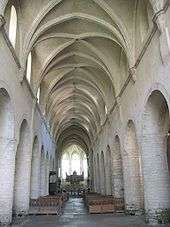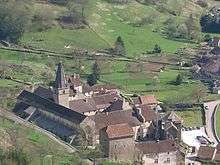Baume Abbey

Baume Abbey, in its village of Baume-les-Messieurs, Jura, France, was founded as a Benedictine abbey not far from the still-travelled Roman road linking Besançon and Lyon.[1] It stands near the source of the Dard[2] in the Jura, France. Around it the picturesque village of Baume-les-Messieurs is congregated. The abbey is famous for its sixteenth-century retable.
Early history
The abbey's origins had been irretrievably lost to memory when Jean Mabillon inquired at the end of the 17th century, though an eleventh-century source and Peter the Venerable in the following century recorded a tradition Mabillon followed, that it had been founded by Saint Columbanus, which would place the foundation in the late sixth century.[3] In 732 Saracen raiders destroyed the obscure community of monks, along with neighboring Château-Châlon and the village of Lons-le-Saunier.[4] It was refounded during the reign of Louis the Pious in the early ninth century by Saint Eutice,[5] probably a disciple of Benedict of Aniane, who was revitalizing and reordering the Benedictine communities of the Gauls. In 817, when Emperor Louis at Aachen divided the monasteries in his lands into three categories, monasterium Balma was one of only twelve that owed him annual subsidies.[6]

Passing through Besançon on his way to Rome in 869, Lothaire granted Baume and all its lands and goods to Arduic, archbishop of Besançon, but he died before the transfer could take effect. Beaume was among the royal properties that fell to the lot of Louis the German at the division effected in May 870.[7] After the desolation of Burgundy by the Normans, 887—899, once again it had fallen into such desuetude, that its second refounding abbot,[8] Berno, who was later called from Baume to found Cluny Abbey in 910, is generally credited with being its founder, about 890.[9] Berno was confirmed as abbot in 895 by Pope Formosus, who took it and all its lands under the protection of the Holy See, asserting the right of the community to elect their own abbot, and threatening with excommunication any lay lord who might attach its lands and revenues; Berno took the prudent step of placing Baume under the secular patronage of Rudolph I of Burgundy.
About 909, Odo with his noble companion Adegrin, found Baume and became a monk, priest, and then superior of the abbey school, bringing with him a library of 100 books.[10]
Subsequently, however, without the invigorating presence of Berno's first successors, Baume suffered a century of eclipse, before papal authority gave it in 1147 to Peter the Venerable, abbot of Cluny; dedicated to Saints Peter and Paul, Baume — in a sense the mother-house of Cluny — thus became a Cluniac priory.
The notorious Jean de Watteville was abbé de Baume. Baume was secularised in 1753 and its canons were expelled in 1790, at the start of the French Revolution, when Baumes-les-Moines became Baume-les-Messieurs.

In popular culture
- In the novel Raptor, the protagonist Thorn is born and lives his youth in the Abbey of St. Damian Martyr within a ringed cliff formation known in Gothic as the Balsan Hrinkhen (French: Cirque de Baume; likely based on the formation in Baume-les-Messieurs, where Baume Abbey is located).
References
- ↑ Bernard Prost, Essai historique sur les origines de l'abbaye de Baume-les Moines, 1872:4.
- ↑ The actual source is the show cave les Grottes de Baume-les-Messieurs
- ↑ Prost 1872:12 note 2, 13.
- ↑ Prost 1872:15.
- ↑ His commemoration falls on 13 January, but the date of his death is uncertain; Prost (1872:20 note 3) gives sources for the few traditional hagiographic details of his life.
- ↑ Prost 1872:21-23.
- ↑ Prost 1872:23ff.
- ↑ Prost quotes a charter of Rudolph I of Burgundy, 903: "Quamdam cellam nomine Balmam, quam ipsi monachi prælibati ad fundamentum reædificaverunt", "that same cell, Baume by name, that the same aforesaid monks will have rebuilt from the ground up"
- ↑ Date in Prost 1872:31.
- ↑ Prost 1872:40.
External links
| Wikimedia Commons has media related to Abbaye de Baume-les-Messieurs. |
- Visiting information (French)
- Baume-les-Messieurs
Coordinates: 46°42′28″N 5°38′55″E / 46.70778°N 5.64861°E